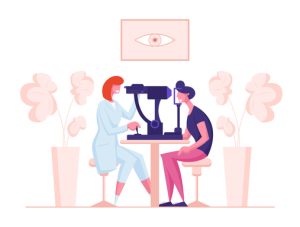Now that you’ve survived your first year in optom, it’s time for the second! I hope you enjoyed Part 2 because Part 3 gets much better. You won’t be seeing patients, and things are pretty chill. This post will be shorter than the part 2 guide, and we will post specific tips and tricks before your assessments instead. There was much less information given for part 3 compared to part 2. Take this guide as reassurance when you are feeling lost.
OPTOM 316
In this course, you will learn about various parts of the eye exam, such as theory and lab practicals. You will also learn about different optical lens designs (SVD, progressives etc.) and which designs to recommend to patients. Some parts of the theory can be difficult, but you should be okay with time and practical experience in labs.
Labs
316 labs make up the majority of labs in this course, and it’s really fun. You will learn different parts of an eye test where you can put theory into practice. Labs differ this year because there will be little to no demonstrations, so make sure you read the lab guide well before each lab. Most labs require you to get straight into it with little to no additional information. You must revise well before the labs and complete the pre-lab quizzes. The pre-lab quizzes are easy, so don’t stress about this. There are several Hurdle assessments, and we will make some tips and tricks for you 😉 Stay updated on our Facebook page!
Goal Settings
There is a goal settings assessment where you will make and monitor your goals throughout the year. This shouldn’t be TOO difficult and don’t stress if you don’t achieve your goals. You are being marked on self-reflection, not how well you can achieve your goals. For most people, thinking about a goal is the most challenging part of the assessment.
Tests
There are two written tests; for us, it was an online and open-book test. You probably won’t have the luxury of an online test! Despite being an online test, many of us needed more time. You should revise well for these tests and know the learning objectives. Don’t stress if you don’t do too well in them. Everyone is in the same boat.
OPTOM 345
In OPTOM 345, you will learn about different types of drugs and how they work. I found this course hard because the content was very different to what we’ve done before. Some concepts were boring, especially remembering drug names and functions. There are no tests for this course, but there are four 15-question MCQ quizzes that account for 20% of your overall grade. Usually, these MCQs are sat in person, but because of Covid, they were online. These quizzes are timed, so you should revise before sitting them because you will likely run out of time otherwise.
Labs
There will be two labs in the first half of sem 2 where you will collect data on the effects of eye drugs. Then you will make some graphs and answer questions. You will be surprised to learn that this makes up 20% of your overall grade. Although the lab report questions look easy, the grade distribution is quite wide, but don’t stress too much for this report.
OPTOM 353
This course is very much like OPTOM 275 but with more pathologies of the eye. You will learn about different diseases of the eye and some potential treatments. There is a LOT of content to learn, and a lot of the time, you just need to wrote learn. I recommend making tables for each topic since multiple diseases are covered in each lecture. Although there is a lot to learn, the content is exciting and straightforward.
PBL
There are no labs for this course, but you will be placed in PBL groups and take turns presenting cases to the class. You will analyse cases as a group and present and answer questions at the end of your presentation. When your group is not presenting, you will complete an MCQ quiz related to the presented topics. This was very enjoyable, and the cases and quizzes weren’t hard at all. There will be a case analysis lab video to watch before this, so read the lab guide before you watch it. You will present once per semester.
Tests
There are two semester tests which are half an hour long. Many of the questions ask you to compare the signs and symptoms of two similar diseases, so you must know their main differences. These tests compose of short answer questions about pathology and the treatment of diseases. You should really revise well for these tests because you could be short on time if you take too long.
OPTOM 375
This course starts off with Misha and Steven on the psychophysics of vision and stats. The good news is that you have your foundation from part 2, so this shouldn’t be too hard. The stats and calculations can be quite challenging, especially at the beginning. Then you will learn about colour vision and the evolution of colour vision. Despite the challenging content, I actually enjoyed learning about the evolution of colour vision. The second half of the year has no lectures, and you will take turns presenting in your assigned journal clubs.
Tests
Test one will be on the Stevens content. You should be fine if you understand the learning objectives and can draw diagrams to back up your answer. Test two is purely calculations from Misha’s stats lectures. These are difficult, but work through his practice questions and don’t feel bad if you don’t do well. In the final test, you will be tested on the final lectures Misha gave out. You will be glad to hear that there is no final exam for 375.
Poster Presentation
This is where you will pick a recent research paper about vision science to make into an A1 poster and present it to markers of your choice. I made my poster on Google Slides, but there are many ways to make them. Pick a topic you like because you will be placed in Journal Clubs for Semester Two based on your presentations. Let’s say you picked John as your preferred Journal Club, make your poster on a topic in his field and pick him as your marker. The good news is that in semester two, the lectures end for 375, and you will be presenting papers in the journal clubs. Your supervisors in each club will assign you to a paper, and you will present it to your club members and discuss it afterwards. Although this depends on the club, it is pretty chill and shouldn’t be too difficult. However, some lectures mark a bit more harshly than others (John).
The final assessment of the journal club will be making a research proposal (related to your journal club). You will have to make up a new study to research, and again, the hardest part is to think of the title of the study. If you are stuck, explore different studies and think about how you can improve, change, or add to them and use that as your research topic.
Maori Health Intensive
This is a one-week compulsory (during sem break) in-person learning module where you will learn about health inequities and some Maori history. You are arranged into groups where you will tackle a Maori health inequity and find resolutions for your case. You will then present your case to other groups and answer questions. Overall, MHI can be pretty fun, and it’s a great opportunity to meet other people from different clinical programmes such as medicine, nursing, pharmacy etc. This course is compulsory, and you must attend all the sessions.



